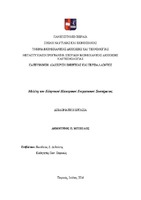Μελέτη του ελληνικού ηλεκτρικού ενεργειακού συστήματος

View/
Keywords
Ανανεώσιμες πηγές ενέργειας ; Συμβατικές πηγές ενέργειας ; Ηλεκτρική ενέργεια ; Ζήτηση ; Αιχμή φορτίου ; Παραγωγή και κατανάλωση ηλεκτρικής ενέργειας ; Συμπαραγωγή ; Conventional energy sources ; Renewable energy ; Cogeneration of electric power and heat ; Electricity demand ; Peak load ; Electricity generationAbstract
Electricity generation in Greece is classified into two major categories according to
the type of the energy sources used: (i) Electricity production from fossil fuels, where
mineral solids, liquids or gases are used. The latter have been formed in earlier
geological periods and stored underground, in smaller or greater depths, in a finite,
non-renewable quantity. (ii) Electricity production from Renewable Energy Sources
(RES), which mainly include solar and wind energy. In this case, the periodicity and
the thoughtfulness of intermittent renewable resources may play an important role in
energy production. More specifically, based on the fuel used in electricity production,
there are (i) Thermal plants, where energy is attributed to the materialused (solid,
liquid or gaseous) for combustion - e.g. lignite, peat, coal, natural gas, diesel, fuel oil,
etc.,ii) Hydro power plants, where energy is attributed to the potential energy of
water, which is converted into kinetic energy during waterfall, (iii) RES technologies,
which encompass wind farms, photovoltaic plants and biomass/biogas plants. The
present diploma thesis is focused on all theabove-mentioned issues in detail. Firstly, a
comprehensive description of the Greek electricity system is presented. The energy
problem in Greece and potential ways of treatment, are also demonstrated.
Subsequently, electricity generation power plants in the country, as well as their
advantages and disadvantages, are described. Moreover, existing conventional and
renewable energy power plants, both in the interconnected grid system and the
isolated/autonomous islands, are presented. Planned accessions and withdrawals by
2020 are also presented and discussed. Finally,energy demand and peak load forecasts
of the Independent Power Transmission Operator (ADMIE) are demonstrated for the
time horizon 2016-2020. Electricity system adequacy is also investigated employing
deterministic and stochastic methods for the time horizon 2016-2020.


